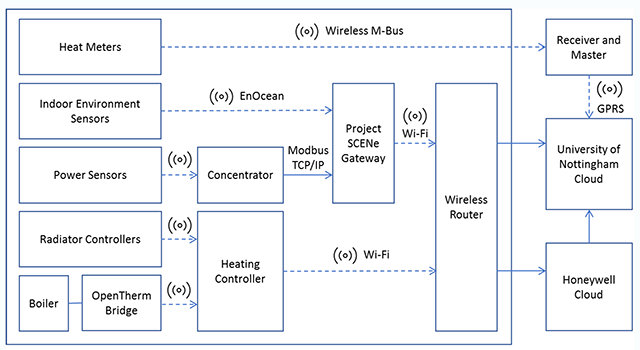Active buildings require data. ‘Things’, such as those producing renewable energy, measuring energy flow or monitoring environmental conditions, must be connected to the Internet to provide the information needed to support the intelligent integration of the buildings into the wider energy infrastructure; they form part of the Internet-of-Things (IoT). If you’ve managed to escape exposure to this buzzword over the last decade or so I’d be amazed.
It doesn’t take much exposure to IoT before you come across another commonly-used word – ‘fragmented’. There are hundreds of different underlying devices, communication protocols, standards and platforms that comprise the IoT ecosystem. This makes implementing an IoT platform for active buildings a complex affair. How do we make such complexity simple on the surface, most importantly i.e. to the consumers of the data?
At the University of Nottingham, we have developed an IoT platform to monitor a community energy scheme at the Trent Basin development. The scheme is a testbed for community energy and includes renewable energy generation, an enormous 2.1MWh community battery and a range of low carbon and energy efficient properties.

The complexity of the infrastructure required to monitor just a single home in the development is clear to see from the diagram above. A range of different technologies are necessary to monitor energy use, indoor environmental conditions and heating behaviour. However, all this data is routed to a single, secure, cloud-based location.
Functions are spun-up on demand to process incoming data into a common format, store it in a scalable database, and automatically generate statistics. Access to the data is made available to our partners using an application programming interface (API) that allows their services to talk to ours and consume the data they need for applications such as the creation of digital replicas of buildings.
This interface is defined using the industry standard OpenAPI specification, which allows humans and machines to discover and understand the data without having to delve deeper into the underlying complexity. The ease of data consumption can be further enhanced by adopting common naming standards such as those that ABC-RP are helping to define. The simpler we can make the discovery and access of data from active and low carbon buildings, the easier it will be to create services of value that will contribute to our net-zero goals.
The development of this platform is continuing as part of ABC-RP where it underpins the Behind-The-Meter project at Trent Basin which aims to optimise the mix of locally-generated and utility provided energy for residents.
To learn more about some of the equipment installed in participating properties see this video.
Rob Shipman is a Senior Research Fellow at the University of Nottingham where he developed the monitoring, IoT and cloud infrastructure for the Trent Basin development in Nottingham, which is being utilised and further enhanced as part of the Active Building Centre Research Programme.


